External links
| |||||||||||||||||||||||||
| |||||||||||||||||||||||||
| |||||||||||||||||||||||||
| |||||||||||||||||||||||||
Meretnebty was a queen consort of Egypt as a wife of Pharaoh Sahure. [1] She lived during the 5th Dynasty and was named after Two Ladies, a pair of Egyptian goddesses who protected the pharaoh.
Meretnebty's parents are not known. She is depicted with her husband in his mortuary temple at Abusir. [2] In the temple she is shown next to the mother of Sahure, Neferhetepes. Both holding their hands. That is a highly unusual depiction and might indicate a close relationship between both. Perhaps Neferhetepes was her mother. [3] In the mortuary temple several sons are mentioned. Their names are Horemsaf, Netjerirenre, Khakare and Nebankhre. It is not clear if these princes are the sons of Meretnebty or possibly of another wife. [4] Meretnebty's titles include those of great of praises, she who sees Horus and Seth, king’s wife, his beloved, and companion of Horus . [5]
Sahure and Meretnebty's children may have been Princes Ranefer and Netjerirenre. According to Miroslav Verner, Ranefer took the throne as Neferirkare Kakai, and Netjerirenre may have later taken the throne as Shepseskare. [6]
The queen was known for a long time from depictions in the pyramid temple of Sahure. However, the name there was partly destroyed and was reconstructed as Neferet-ha-Nebti or Neferetnebti. In more recent excavations blocks with depictions of the queen were found and her name is completely preserved as Meretnebty. [7]

Sahure was a pharaoh of ancient Egypt and the second ruler of the Fifth Dynasty. He reigned for about 13 years in the early 25th century BC during the Old Kingdom Period. Sahure's reign marks the political and cultural high point of the |Fifth Dynasty. He was probably the son of his predecessor Userkaf with Queen Neferhetepes II, and was in turn succeeded by his son Neferirkare Kakai.

Huni was an ancient Egyptian king, the last pharaoh of the Third Dynasty of Egypt during the Old Kingdom period. Based on the Turin king list, he is commonly credited with a reign of 24 years, ending c. 2613 BC.
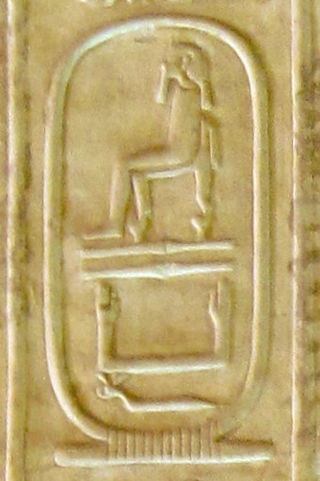
Shepseskaf was a pharaoh of ancient Egypt, the sixth and probably last ruler of the fourth dynasty during the Old Kingdom period. He reigned most probably for four but possibly up to seven years in the late 26th to mid-25th century BC.

Userkaf was a pharaoh of ancient Egypt and the founder of the Fifth Dynasty. He reigned for seven to eight years in the early 25th century BC, during the Old Kingdom period. He probably belonged to a branch of the Fourth Dynasty royal family, although his parentage is uncertain; he could have been the son of Khentkaus I. He had at least one daughter and very probably a son, Sahure, with his consort Neferhetepes. This son succeeded him as pharaoh.

Neferirkare Kakai was an ancient Egyptian pharaoh, the third king of the Fifth Dynasty. Neferirkare, the eldest son of Sahure with his consort Meretnebty, was known as Ranefer A before he came to the throne. He acceded the day after his father's death and reigned for eight to eleven years, sometime in the early to mid-25th century BCE. He was himself very likely succeeded by his eldest son, born of his queen Khentkaus II, the prince Ranefer B who would take the throne as king Neferefre. Neferirkare fathered another pharaoh, Nyuserre Ini, who took the throne after Neferefre's short reign and the brief rule of the poorly known Shepseskare.

Menkauhor Kaiu was an Ancient Egyptian pharaoh of the Old Kingdom period. He was the seventh ruler of the Fifth Dynasty at the end of the 25th century BC or early in the 24th century BC.

Neferefre Isi was an ancient Egyptian pharaoh of the Fifth Dynasty during the Old Kingdom period. He was most likely the eldest son of pharaoh Neferirkare Kakai and queen Khentkaus II. He was known as prince Ranefer before he ascended to the throne.
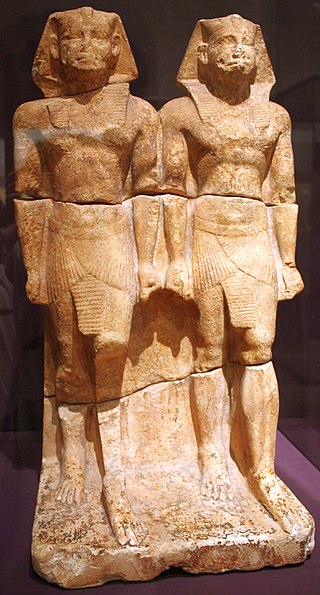
Nyuserre Ini was an Ancient Egyptian pharaoh, the sixth ruler of the Fifth Dynasty during the Old Kingdom period. He is credited with a reign of 24 to 35 years depending on the scholar, and likely lived in the second half of the 25th century BCE. Nyuserre was the younger son of Neferirkare Kakai and queen Khentkaus II, and the brother of the short-lived king Neferefre. He may have succeeded his brother directly, as indicated by much later historical sources. Alternatively, Shepseskare may have reigned between the two as advocated by Miroslav Verner, albeit only for a few weeks or months at the most. The relation of Shepseskare with Neferefre and Nyuserre remains highly uncertain. Nyuserre was in turn succeeded by Menkauhor Kaiu, who could have been his nephew and a son of Neferefre.

Shepseskare or Shepseskara was an Ancient Egyptian pharaoh, the fourth or fifth ruler of the Fifth Dynasty during the Old Kingdom period. Shepseskare lived in the mid-25th century BC and was probably the owner of an unfinished pyramid in Abusir, which was abandoned after a few weeks of work in the earliest stages of its construction.

Abusir is the name given to an ancient Egyptian archaeological pyramid complex comprising the ruins of 4 kings' pyramids dating to the Old Kingdom period, and is part of the Pyramid Fields of the Memphis and its Necropolis UNESCO World Heritage Site.
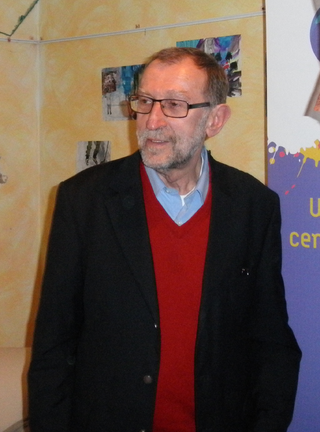
Miroslav Verner is a Czech egyptologist, who specializes in the history and archaeology of Ancient Egypt of the Old Kingdom and especially of the Fifth Dynasty of Egypt.

The pyramid of Neferirkare was built for the Fifth Dynasty pharaoh Neferirkare Kakai in the 25th century BC. It was the tallest structure on the highest site at the necropolis of Abusir, found between Giza and Saqqara, and still towers over the necropolis. The pyramid is also significant because its excavation led to the discovery of the Abusir Papyri.

The pyramid complex of Userkaf was built c. 2490 BC for the pharaoh Userkaf, founder of the 5th Dynasty of Egypt. It is located in the pyramid field at Saqqara, on the north-east of the step pyramid of Djoser. Constructed in dressed stone with a core of rubble, the pyramid is now ruined and resembles a conical hill in the sands of Saqqara. For this reason, it is known locally as El-Haram el-Maharbish, the "Heap of Stone", and was recognized as a royal pyramid by western archaeologists in the 19th century.

The pyramid of Sahure is a pyramid complex built in the late 26th to 25th century BC for the Egyptian pharaoh Sahure of the Fifth Dynasty. It introduced a period of pyramid building by Sahure's successors in Abusir, on a location earlier used by Userkaf for his sun temple. The site was first thoroughly excavated by Ludwig Borchardt between March 1907 and 1908, who wrote the standard work Das Grabdenkmal des Königs Sahu-Re between 1910 and 1913.

The pyramid of Neferefre, also known as the pyramid of Raneferef, is a 25th century BC unfinished pyramid complex built for the Egyptian pharaoh Neferefre of the Fifth Dynasty. Neferefre's unfinished pyramid is the third and final one built on the Abusir diagonal – a figurative line connecting the Abusir pyramids with Heliopolis – of the necropolis, sited south-west of Neferirkare's pyramid.

Neferhetepes was an ancient Egyptian princess of the 4th Dynasty; a daughter of Pharaoh Djedefre who ruled between his father Khufu and his brother Khafre. Her mother was Hetepheres II.
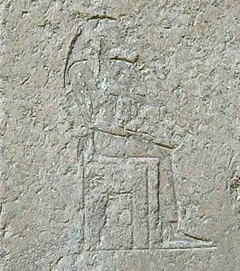
Khentkaus I, also referred to as Khentkawes, was a royal woman who lived in ancient Egypt during both the Fourth Dynasty and the Fifth Dynasty. She may have been a daughter of king Menkaure, the wife of both king Shepseskaf and king Userkaf, the mother of king Sahure.
Neferhetepes was the wife of the ancient Egyptian king Userkaf, who was the first pharaoh of the Fifth Dynasty. She was the mother of king Sahure, Userkaf's successor, and she was most likely the mother of Meretnebty, Sahure's wife. Neferhetepes' most important titles were mother of the king of Upper and Lower Egypt and daughter of the god.
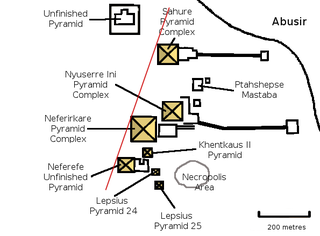
The unfinished pyramid of Abusir is an abandoned pyramid complex located in the necropolis of Abusir whose construction began in the Fifth Dynasty. It is speculatively assigned to Shepseskare, an ephemeral pharaoh whose brief rule is the least well documented of the Fifth Dynasty.

The pyramid of Nyuserre is a mid-25th-century BC pyramid complex built for the Egyptian pharaoh Nyuserre Ini of the Fifth Dynasty. During his reign, Nyuserre had the unfinished monuments of his father, Neferirkare Kakai, mother, Khentkaus II, and brother, Neferefre, completed, before commencing work on his personal pyramid complex. He chose a site in the Abusir necropolis between the complexes of Neferirkare and Sahure, which, restrictive in area and terrain, economized the costs of labour and material. Nyuserre was the last king to be entombed in the necropolis; his successors chose to be buried elsewhere. His monument encompasses a main pyramid, a mortuary temple, a valley temple on Abusir Lake, a causeway originally intended for Neferirkare's monument, and a cult pyramid.